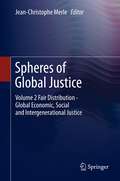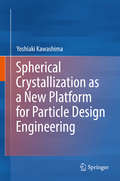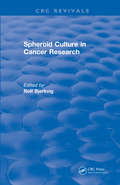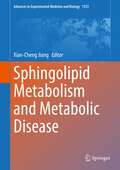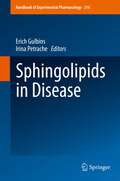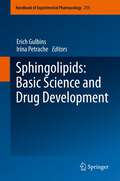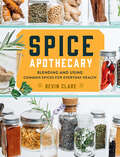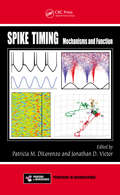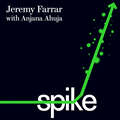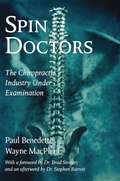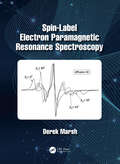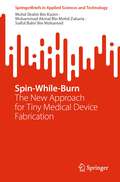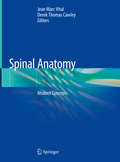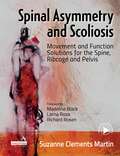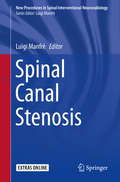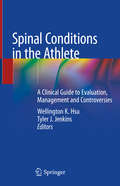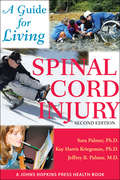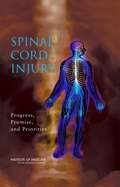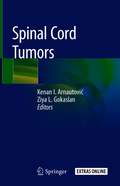- Table View
- List View
Spezielle validierende Pflege: Emotion vor Kognition
by Sonja Scheichenberger Brigitte ScharbDas Buch stellt das von Brigitte Scharb entwickelte Pflegekonzept zur Befriedigung psychosozialer Grundbedürfnisse desorientierter, hochbetagter Personen vor, mit dem Ziel vorhandene Kompetenzen der Betroffenen zu fördern bzw. zu bewahren. Das Konzept basiert auf einer präzisen Dokumentation und Biographieerhebung unter Einsatz validierender Techniken (nach Naomi Feil) bzw. Pflegemaßnahmen. Diese vierte erweiterte und neu strukturierte Auflage ist gleichzeitig die erste, die nach dem viel zu frühen Tod von Brigitte Scharb entstand. Sie orientiert sich dabei an den Darstellungen der vorangehenden Ausgaben, wobei die Autorin Ergänzungen in den Grundlagen vorgenommen, die spirituellen Bedürfnisse integriert, die Pflegedokumentation auf die POP Diagnosen umgestellt und die Perspektiven der Betroffenen sowie Angehörige näher beleuchtet hat. Zahlreiche praktische Fallbeispiele illustrieren anschaulich wie ein entsprechendes Bedürfniskonzept erstellt und dokumentiert wird. Das Buch richtet sich an stationäre und ambulante Pflegepersonen, Altenbetreuung, Heimhilfe sowie Betroffene und Angehörige.
Spheres of Global Justice: Volume 1 Global Challenges to Liberal Democracy. Political Participation, Minorities and Migrations; Volume 2 Fair Distribution - Global Economic, Social and Intergenerational Justice
by Jean-Christophe MerleSpheres of Global Justice analyzes six of the most important and controversial spheres of global justice, each concerning a specific global social good. These spheres are democratic participation, migrations, cultural minorities, economic justice, social justice, and intergenerational justice. Together they constitute two constellations dealt with, in this collection of essays by leading scholars, in two different volumes: Global Challenges to Liberal Democracy and Fair Distribution. These essays illustrate each of the spheres, delving into their differences, commonalities, collisions and interconnections. Unlike many writings on global justice, Spheres of Global Justice does not content itself with describing the painful and advantageous effects of the globalization process as being ipso facto a global injustice or a just global order. Rather, this multidisciplinary collection of essays, from a pluralist inspiration, combines empirical analysis with theoretical approaches and ethical principles, paying close attention to two aspects of the effects of the globalization process. These aspects are the causal relationships that lead to such effects and the kinds of obligations, or of normative relationships between global rights and correlative duties, that applies to each specific individual case. This volume illustrates how diverse global obligations are, and how they can be, grounded in diverse relationships (identity, ability to provide help, causal responsibility, past injustices, protection of agency and promotion of independence, etc.). These essays also demonstrate that an ethical global approach has not only international or transnational, but also domestic, local and interpersonal dimensions.
Spherical Crystallization as a New Platform for Particle Design Engineering
by Yoshiaki KawashimaThis book describes the principles and applications of the spherical crystallization technique, from the standpoint of its inventor. After an introduction on the history of particle design engineering and nanotechnology, the concept of spherical crystallization itself is clearly explained. Attention then turns to the application of spherical crystallization in pharmaceutical processes. It is explained how the technique can provide physicochemical properties suitable for direct tableting of active pharmaceutical ingredients and how it has enabled the development of a novel particulate design platform from single to complex system. Subsequent chapters describe the roles of polymeric spherical crystallization in the preparation of novel microspheres, microballoons for drug delivery systems (DDS) and the development of biocompatible and biodegradable poly(D,L-lactide-co-glycolide) (PLGA) nanospheres. The various applications of PLGA nanospheres composite within oral-, pulmonary-, transdermal DDS and cosmetics are fully discussed. Finally, future perspectives are presented on use of the technology in the design and industrial-scale manufacture of new drug delivery systems, highlighting how a continuous pharmaceutical process that meets US Food and Drug Administration quality requirements should soon be introduced.
Spheroid Culture in Cancer Research (CRC Press Revivals)
by Rolf BjerkvigSpheroid Culture in Cancer Research describes the various techniques now available for establishing spheroid tissue culture, including spheroid culture from normal tissues and from tumor cell lines. The book also describes how the spheroid system can be used to study interactions between normal and malignant cells. Microenvironmental conditions in spheroids and how this micromilieu may promote cellular heterogeneity and histiotypic structures not observed in corresponding monolayer cultures are discussed. The biological importance of oxygen tension, pH gradients, diffusions of nutrients, and cell-cell communication in spheroids are also examined.The book will be profoundly important to researchers in experimental chemotherapy, radiotherapy, immunotherapy, and hyperthermia.
Sphingolipid Metabolism and Metabolic Disease (Advances in Experimental Medicine and Biology #1372)
by Xian-Cheng JiangThis book provides an up-to-date review of the fundamentals of sphingolipid metabolism and its role in metabolic diseases. Focusing on the sphingolipid de novo synthesis pathway, the effect of sphingomyelin, ceramide, and sphingosine-1-phosphate, and linkage between sphingolipids and other lipids, such as cholesterol, it covers serine palmitoyltransferase, ceramide synthases, ceramidases, sphingosine kinases, and sphingomyelin synthases, and more. While highlighting how rare diseases related to abnormal glycosphingolipid metabolism, this publication introduces sphingolipid metabolism-related diseases, such as lung diseases and cancers, as well as sphingolipid circadian regulation. The book demonstrates advances and limitations of research on sphingolipid metabolism and its roles in metabolic diseases and other diseases. It offers graduate students and researchers a coherent overview of sphingolipids, as well as the limitations of current research in the field, and promotes further studies on metabolic diseases, as well as pharmaceutical research on drug discovery based on sphingolipid de novo synthase.
Sphingolipids in Disease
by Irina Petrache Erich GulbinsSphingolipids are lipid components of the plasma membrane of eukaryotic cells with an important function in signaling mechanisms in the cell. This book provides insight into the physiological and pathophysiological role of sphingolipids and in particular its derivative ceramide. The function of Sphingolipids in cell signaling with regard to infectious and lung diseases, cancer, cardiovascular diseases and neuropsychiatric disorders are described and treated in distinct parts. Together with Volume 215 from the same Editors, the collection represents a unique, comprehensive work on Sphingolipids, providing information on both: Sphingolipid basic biology as well as its important function in a (patho)physiological context. The book is written for scientists in pharmacology, biochemistry and cell biology with a focus on biomedical research as well as for clinicians in pharmacology, oncology, cardiology, neurology and infectious disease.
Sphingolipids: Basic Science and Drug Development
by Irina Petrache Erich GulbinsSphingolipids are lipid components of the plasma membrane in eukaryotic cells. They have an important function in signaling mechanisms in the cell. This book on sphingolipids provides insights into the basics of sphingolipid biology and drug development, with a particular emphasis on the sphingolipid derivative ceramide. In the first part basic functions of sphingolipids are described, as well as the genetics of important enzymes, sphingolipid metabolism and synthesis. The second part of this first volume focuses on drug development and pharmacology. The book is intended for scientists in pharmacology, biochemistry and cell biology with a focus on biomedical research as well as for clinicians working in pharmacology, oncology, cardiology, neurology and infectious disease. Together with Volume 216 by the same editors, the collection represents a unique, comprehensive work on sphingolipids, providing information on both sphingolipids' basic biology (including synthesis, metabolism and cell biology) and their important function in a (patho-)physiological context.
Spice Apothecary: Blending and Using Common Spices for Everyday Health
by Bevin ClareSpices are universally recognized as a source of flavor and aromatics, but in cultures around the world, these plant parts have a long history as source of medicine. In Spice Apothecary, author Bevin Clare combines her training in herbalism and nutrition to inspire a return to the kitchen spice cabinet for better health and healing. Focusing on 19 common culinary spices that are easy to source and prized for their flavor, this practical guide highlights each spice&’s role in supporting wellness goals and delivers creative and impactful ways to incorporate key health-boosting spices into everyday life. To bolster the immune system, chili, garlic, ginger, and mustard are best. Celery seed, parsley, and sage support kidney function, while the respiratory system benefits most from ginger, mint, and thyme. Learn the best way to harness each spice&’s medicinal power, the proper way to store spices, and how to determine your daily dose. Then, prepare customized dried spice blends and use them in delicious dips, soups, sauces, and even sweets that deliver flavor and healing. This publication conforms to the EPUB Accessibility specification at WCAG 2.0 Level AA.
Spiegel der Wirklichkeit: Anatomische und Dermatologische Modelle in der Heidelberger Anatomie
by Sara Doll Navena WidulinIn diesem Buch werden Modelle aus dem Fundus des Instituts für Anatomie und Zellbiologie der Universität Heidelberg vorgestellt. Diese mobilen Kulturgüter erzählen vielseitige Geschichten über interdisziplinäre Beziehungen, historische Forschungsansätze, ihren Erstellungskontext, Herstellungsprozesse und zeigen Verbindungen zu anderen Institutionen auf.Die Beiträge beleuchten den kulturwissenschaftlichen Hintergrund der Objekte, der oft weit über die offensichtliche Verwendung derselben in der Lehre hinausgeht.
Spiegeltherapie in Physiotherapie und Ergotherapie
by Farsin HamzeiDieses Praxisbuch gibt Physiotherapeuten und Ergotherapeuten den perfekten Überblick über die Spiegeltherapie. Erfahren Sie, wie Lernen und Trainieren nach zentralen Läsionen funktioniert, welche Rolle Bewegungsbeobachtung dabei spielen kann und was die Transcranial direct current stimulation damit zu tun hat. Zahlreiche Studienergebnisse werden übersichtlich zusammengefasst und hilfreiche Tipps für die Praxis abgeleitet.Aus dem Inhalt:• Neurophysiologische Grundlagen u.a. neuronale Plastizität und die Funktion von Spiegelneuronen• Indikationen wie z. B. Phantomschmerz, periphere Nervenläsionen oder Schlaganfall• Kombinationstherapien zur Optimierung der Therapieeffekte
Spiel und Magie in der Psychoanalyse: Setting, Rahmen, Regeln (essentials)
by Diana PflichthoferDiana Pflichthofer nähert sich dem Thema der Psychoanalyse auf neuem Wege: Sie erläutert die spielerischen und magischen Elemente, die in besonderer Weise bei der Arbeit in der Übertragung zur Geltung kommen. Indem die Psychoanalytikerin eine ihr vom Patienten unbewusst zugewiesene Übertragungsrolle annimmt, lässt sie sich auf diese psychische Realität ein, wie jemand sich auf die Realität eines Spiels einlässt. Dabei muss sich die Analytikerin der Tatsache bewusst sein, dass ihr - gefördert durch den Rahmen und die Regeln - magische Eigenschaften zugeschrieben werden, die ihr eine Machtposition verleihen. Sie darf diese Macht jedoch niemals missbrauchen, sondern muss sie stets in den Dienst der Autonomie-Entwicklung des Analysanden stellen.
Spielanalyse im Sportspiel
by Daniel MemmertProfessionelle Spielanalysen – sei es im Training zur Gegnervorbereitung, im Wettkampf oder zur Nachbereitung – sind in Mannschafts- und Rückschlagsportarten heute auf unterschiedlichen Expertise-Ebenen unverzichtbar. Durch den Einsatz in den vier großen Anwendungsfeldern Vereine und Verbände, Wirtschaft, Wissenschaft sowie Medien ist ein völlig neuer Markt entstanden, der innerhalb der universitären Forschungs- und Lehraktivitäten zunehmend an Bedeutung gewinnt. In diesem prägnanten Lehrbuch stellen über 30 Autoren die historischen, wissenschaftlichen, praktischen und kommunikativen Aspekte von Spielanalysedaten vor. Zudem werden die vielfältigen Anwendungsmöglichkeiten von Videodaten in den Sportarten American Football, Beach-Volleyball, Cricket, Eishockey, Handball, Hockey, Rugby, Squash, Tennis, Tischtennis und Volleyball praxisnah erläutert. Studierende mit Bezug zur Sportwissenschaft erhalten einen umfassenden Einblick in die Spielanalytik auf der Basis von Video-, Event- und Positionsdaten und unterstützt durch ein didaktisch ausgefeiltes Konzept, das eine einfache Vermittlung der Lerninhalte ermöglicht. Zahlreiche digitale Lernkarten untermauern den Lerneffekt und gewährleisten eine optimale Prüfungsvorbereitung. Für Fortgeschrittene bietet die vertiefende Diskussion von Leistungsparametern in Bezug auf Geschlecht, Scouting oder Gegenpressing einen zusätzlichen Mehrwert.
Spike Timing: Mechanisms and Function
by Patricia M. DiLorenzo Jonathan D. VictorNeuronal communication forms the basis for all behavior, from the smallest movement to our grandest thought processes. Among the many mechanisms that support these functions, spike timing is among the most powerful and-until recently-perhaps the least studied. In the last two decades, however, the study of spike timing has exploded. The heightened
Spike: The Virus vs. The People - the Inside Story
by Anjana Ahuja Jeremy Farrar***THE TOP 5 SUNDAY TIMES BESTSELLER***A pulse-racing journey through the science and politics of the pandemic. Did the UK government really 'follow the science' throughout the Covid-19 pandemic, as it claims?The Coronavirus pandemic has devastated lives and livelihoods around the world - and continues to do so. These personal tragedies will, and must, be told and heard. There is, however, also a truthful and objective scientific narrative to be written about how the virus played out and how the world set about dealing with it. Spike is that story -from the inside. Its author, Jeremy Farrar, is one of the UK's leading scientists and a - member of the SAGE emergency committee.As head of the Wellcome Trust, and an expert in emerging infectious diseases, Jeremy Farrar was one of the first people in the world to hear about a mysterious new respiratory disease in China - and to learn that it could readily spread between people. Farrar describes how it feels as one of the key scientists at the sharp end of a fastmoving situation, when complex decisions must be made quickly amid great uncertainty. His book casts light on the UK government's claims to be 'following the science' in its response to the virus, and is informed not just by Farrar's views but by interviews with other top scientists and political figures.Farrar, who has spent his career on the frontlines of epidemics including Nipah virus in Malaysia, bird flu in Vietnam and Ebola in West Africa, also reflects on the wider issues of Covid-19: the breath-taking scientific advances in creating tests, treatments and vaccines; the challenge to world leaders to respond for the global good and the need to address inequalities that hold back success against the virus. All these shape how the world ultimately fares not just against Covid-19, but against all the major health challenges we face globally.
Spin Doctors: The Chiropractic Industry Under Examination
by Paul Benedetti Wayne Macphail Dr Brad Stewart Dr Stephen BarrettCanadians visit chiropractors about 30 million times a year, and surveys show that patients are generally satisfied with their treatment. But studies also show that as many as two hundred Canadians a year suffer strokes brought on by neck manipulation. Spin Doctors takes a hard, dramatic, and spine-chilling look into the world of chiropractic medicine. You will be surprised to learn what chiropractors treat and why and how much it costs you as a taxpayer. Most importantly, you’ll learn how to protect yourself and your family from dangerous adjustments, practice-building tactics, bogus treatments, and misleading information.
Spin-Label Electron Paramagnetic Resonance Spectroscopy
by Derek MarshSpin-label electron paramagnetic resonance (EPR) spectroscopy is a versatile molecular probe method that finds wide application in molecular biophysics and structural biology. This book provides the first comprehensive summary of basic principles, spectroscopic properties, and use for studying biological membranes, protein folding, supramolecular structure, lipid-protein interactions, and dynamics. The contents begin with discussion of fundamental theory and practice, including static spectral parameters and conventional continuous-wave (CW) spectroscopy. The development then progresses, via nonlinear CW-EPR for slower motions, to the more demanding time-resolved pulse EPR, and includes an in-depth treatment of spin relaxation and spectral line shapes. Once the spectroscopic fundamentals are established, the final chapters acquire a more applied character. Extensive appendices at the end of the book provide detailed summaries of key concepts in magnetic resonance and chemical physics for the student reader and experienced practitioner alike. Key Features: Indispensable reference source for the understanding and interpretation of spin-label spectroscopic data in its different aspects. Tables of fundamental spectral parameters are included throughout. Forms the basis for an EPR graduate course, extending up to a thorough coverage of advanced topics in Specialist Appendices. Includes all necessary theoretical background. The primary audience is research workers in the fields of molecular biophysics, structural biology, biophysical chemistry, physical biochemistry and molecular biomedicine. Also, physical chemists, polymer physicists, and liquid-crystal researchers will benefit from this book, although illustrative examples used are often taken from the biomolecular field. Readers will be postgraduate researchers and above, but include those from other disciplines who seek to understand the primary spin-label EPR literature.
Spin-While-Burn: The New Approach for Tiny Medical Device Fabrication (SpringerBriefs in Applied Sciences and Technology)
by Saiful Bahri Mohamed Mohd Shahir Kasim Muhammad Akmal ZakariaThis book explains the challenges and advancements in cutting precise cylindrical shapes on difficult materials through spark erosion. Titled "Spin while Burn," it addresses the drawbacks associated with this process, including unsatisfactory surface finish and limited productivity. Despite utilizing advanced computing and statistical optimization methods, achieving the ideal balance between material removal rate (MRR) and surface quality remains elusive. In response, the book introduces a hybrid ultrasonic-assisted approach in the wire electrical discharge turning (WEDT) process. By integrating a rotating workpiece with ultrasonic vibration, the authors evaluate its impact on MRR and surface finish. Through meticulous design experiments and statistical analysis, they explore various cutting parameters and machining paths. The book highlights the characterization of machined surfaces through elemental analysis and surface morphology evaluations. The results demonstrate the positiveeffects of integrating ultrasonic vibration into WEDT, even without optimized ultrasonic parameters. By reducing electrode wire debris and employing multi-objective parameter optimization using the genetic algorithm, significant improvements are achieved in MRR and surface roughness compared to conventional WEDT. "Spin while Burn" consists of five chapters, delving into the challenges, history, principles, performance, and future perspectives of the Spin-while-Burn process in manufacturing. This comprehensive book offers valuable insights into enhancing surface quality and productivity in the cutting of precise cylindrical shapes on challenging materials through spark erosion.
Spinal Anatomy: Modern Concepts
by Jean Marc Vital Derek Thomas CawleyThis richly illustrated and comprehensive book covers a broad range of normal and pathologic conditions of the vertebral column, from its embryology to its development, its pathology, its dynamism and its degeneration. The dynamic anatomy of the living subject is viewed using the latest technologies, opening new perspectives to elucidate the pathology of the spine and improve spinal surgery. The respective chapters review in depth all sections of the vertebral column and offer new insights, e.g. the 3D study of vertebral movements using the “EOS system,” which makes it possible to define an equilibrium of posture and its limits. New histological and chemical findings on the intervertebral disc, as well as detailed descriptions of the aponeuroses and fasciae, are also provided.Bringing together the experience of several experts from the well-known French school, this book offers a valuable companion for skilled experts and postgraduate students in various fields: orthopedic surgery, neurosurgery, physiotherapy, rheumatology, musculoskeletal therapy, rehabilitation, and kinesiology.
Spinal Asymmetry and Scoliosis: Movement and function solutions for the spine, ribcage and pelvis
by Suzanne Clements MartinDr Martin's book provides a theoretical framework and specific progressive exercises in the Pilates environment in their work with those individuals who have asymmetries of the spine, ribcage and pelvis associated with conditions such as scoliosis. This book helps Pilates instructors who want to move beyond basic certification to work safely and effectively with those who have structural and functional asymmetries.The many musculoskeletal ramifications of spinal asymmetry are explained, based on relevant anatomy and current theories of causes of deformity, thus throwing light on an often confusing topic. A developed framework offers practical solutions that will further the body of knowledge in the specialized education of Pilates instructors by enabling them to learn a safe and systematic method of instructing those with scoliosis.This framework helps instructors administer individualized Pilates exercise progressions. These comprise: creating a client profile for the individual; developing concepts and considerations for effective exercise delivery and execution; and presentation of those exercise progressions.In addition, two important aspects not yet found within the Pilates field are addressed. The first is the importance of the significant role, outlining the scope of practice of the Pilates instructor in the care of those with spinal asymmetries. And secondly is to identify separate approaches necessary for differing populations at distinct times of life. Stages such as youth, and adult each require a certain approach. The decades of young adult, mid-life, and elder years present special challenges due to the co-morbidities associated with the adult with scoliosis.
Spinal Canal Stenosis
by Luigi ManfrèThis easy-to-consult guide describes new minimally invasive procedures for the treatment of spinal canal stenosis that are accompanied by fewer complications and side-effects, reduce the risks of anesthesia, and lower costs. Clear accounts are provided of various CT and X-ray guided techniques for lumbar spinal canal and foraminal stenosis, including the use of spacers and minimally invasive lumbar decompression (MILD). Helpful introductory information is also provided on biomechanics and symptoms. Like other books in the Springer series New Procedures in Spinal Interventional Neuroradiology, this practice-oriented volume will fill a significant gap in the literature and meet the need expressed by a large number of specialists (interventional neuroradiologists and radiologists, neurosurgeons, and orthopedists) for a topical and handy guide that specifically illustrates the presently available materials and methods.
Spinal Conditions in the Athlete: A Clinical Guide to Evaluation, Management and Controversies
by Wellington K. Hsu Tyler J. JenkinsThis concise, user-friendly guide brings together the strongest available evidence with expert recommendations to provide insight into the management of injuries to the athlete’s spine, including controversies unique to this area. Divided into three thematic sections, this information will prove invaluable, as many of the real-world questions surrounding care do not have distinct and obvious answers. Considerations for team physician management comprises part I, including on-field assessment of spine injuries and concussion, rehabilitation and return to play, and complications and post-concussion sequelae. The second and third sections discuss injuries to the cervical spine and the thoracolumbar spine, respectively, describing injury evaluation, management, and outcomes in the elite athlete. Spine conditions have been studied extensively in the general population; however, applying this data to the elite athlete is controversial. Numerous external variables make performance of well-designed clinical trials challenging in this population, and consequently evidence-based recommendations are lacking for the athlete’s spine. Practical and engaging, Spinal Conditions in the Athlete will be an excellent resource for sports medicine specialists, orthopedic and neurosurgeons, and any clinician treating the active patient.
Spinal Cord Injury: A Guide for Living
by Sara Palmer Kay Harris Kriegsman Jeffrey B. PalmerThe authors created this self-help guide for those who have suffered a spinal cord injury because "Our experience... tells us that recovery and successful living after injury go more smoothly when people know what to expect." The descriptions of each aspect of life following the injury, from what happens in the hospital and the emotional effects which accompany the trauma, to the new lives experienced afterward, are supplemented with the personal stories of those who have suffered this injury. Of the three authors, two are psychologists and one is an MD affiliated with the rehabilitation program at Johns Hopkins University School of Medicine. A list of resources is included. Annotation c. Book News, Inc., Portland, OR (booknews.com)
Spinal Cord Injury: A Guide for Living (A Johns Hopkins Press Health Book)
by Sara Palmer Kay Harris Kriegsman Jeffrey B. PalmerFully updated and revised, the second edition of Spinal Cord Injury is the definitive guide for people with SCI and their families. Combining first-person accounts with up-to-date medical information, the book addresses all aspects of spinal cord injury—recovery and coping, sex and family matters, transportation and housing, employment and leisure—and reviews the challenges encountered by people with spinal cord injury throughout their lives. The authors explain how spinal cord injury affects physical functioning and the impact of physical changes on emotions and social life. They offer a holistic approach to recovery that incorporates all aspects of living and emphasizes achieving optimal health, personal fulfillment, and meaningful family and social relationships. The new edition of this helpful book includes a completely revised chapter on recovery and regeneration research, stem cell research, and activity-based therapies. New information is offered on medical and rehabilitative care of children and adolescents as well as preventative health measures for people of all ages living with spinal cord injury. The book includes expanded ideas and resources for socializing, travel, sports and recreation.
Spinal Cord Injury: Progress, Promise, and Priorities
by Institute of Medicine of the National AcademiesAn estimated 11,000 spinal cord injuries occur each year in the United States and more than 200,000 Americans suffer from maladies associated with spinal cord injury. This includes paralysis, bowel and bladder dysfunction, sexual dysfunction, respiratory impairment, temperature regulation problems, and chronic pain. During the last two decades, longstanding beliefs about the inability of the adult central nervous system to heal itself have been eroded by the flood of new information from research in the neurosciences and related fields. However, there are still no cures and the challenge of restoring function in the wake of spinal cord injuries remains extremely complex. Spinal Cord Injury examines the future directions for research with the goal to accelerate the development of cures for spinal cord injuries. While many of the recommendations are framed within the context of the specific needs articulated by the New York Spinal Cord Injury Research Board, the Institute of Medicine's panel of experts looked very broadly at research priorities relating to future directions for the field in general and make recommendations to strengthen and coordinate the existing infrastructure. Funders at federal and state agencies, academic organizations, pharmaceutical and device companies, and non-profit organizations will all find this book to be an essential resource as they examine their opportunities.
Spinal Cord Tumors: Principles And Practice (Thieme Publishers Ser.)
by Ziya L. Gokaslan Kenan I. ArnautovićThis book provides state-of-the-art, in-depth knowledge of spinal cord tumor surgery. After an introduction to the history and etiology of spinal cord tumor treatment, the molecular biology, cytogenetics and pathology of this group of tumors is discussed. The pathological anatomy of spinal cord tumors is described and the book focuses in depth on their diagnosis and the surgical approaches that can be used in their treatment. Microsurgery resection techniques, auxiliary treatment options, prognosis and outcomes of spinal cord, and spinal nerve tumors are all covered in detail. Spinal Cord Tumors is aimed at neurosurgeons and may also be of interest to neurologists, neuro-oncologists, radiologists, physiatrists, pathologists, geneticists, orthopedic surgeons, physical and occupational therapists, and other interested scientists.

